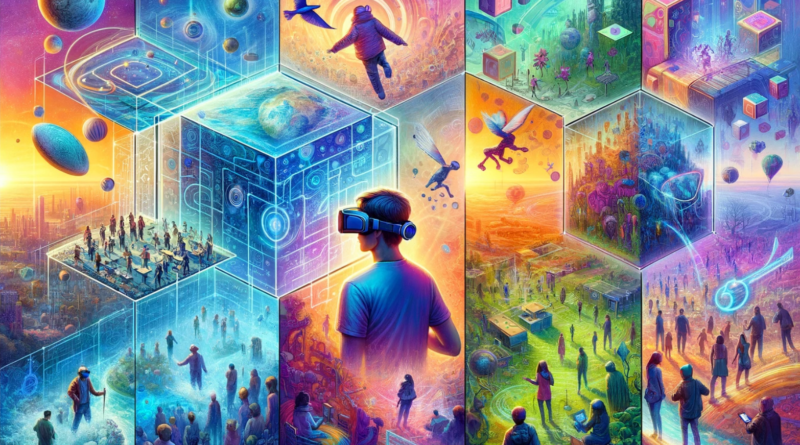Understanding the Metaverse through Four Sociotechnical Dimensions
Understanding the Metaverse through Four Sociotechnical Dimensions
Shahper Richter, Alexander Richter
The term Metaverse stands for the concept of the emerging virtual world that promises to revolutionize how we interact within digital environments and with each other. To fully grasp its potential and complexity, it is essential to understand it through four distinct but interrelated dimensions: Immersiveness, Social Networking, Persistence, and Interoperability. These dimensions serve as a foundation to appreciate the Metaverse’s unique characteristics compared to concepts and implementations of previous virtual spaces like Second Life.
—the Metaverse offers unprecedented opportunities for immersion, social interaction, continuous virtual existence, and seamless integration across different virtual environments—
1. Immersiveness: Bridging Virtual and Physical Realities
Immersiveness refers to the depth of the sensory experience and the extent to which users feel present in the Metaverse. Cutting-edge technologies such as virtual reality (VR) and augmented reality (AR), make the lines between the physical and digital worlds blur. By offering a highly immersive experience, the Metaverse allows users to engage with digital content and interact with others in ways that closely mimic real-life interactions, fostering a more profound sense of presence and engagement.
2. Social Networking: Fostering Community and Connection
 The Metaverse is not just a technological marvel; it’s also a social space where individuals can meet, collaborate, and build communities beyond geographical limitations. This dimension emphasizes the role of social interactions and networking within the Metaverse, enabling users to create and maintain social bonds. Recent advancement of avatar technologies and virtual personas, allow users to express themselves highly individually, participate in shared activities, and contribute to the vibrant social fabric of the Metaverse, making it a dynamic and evolving community.
The Metaverse is not just a technological marvel; it’s also a social space where individuals can meet, collaborate, and build communities beyond geographical limitations. This dimension emphasizes the role of social interactions and networking within the Metaverse, enabling users to create and maintain social bonds. Recent advancement of avatar technologies and virtual personas, allow users to express themselves highly individually, participate in shared activities, and contribute to the vibrant social fabric of the Metaverse, making it a dynamic and evolving community.
3. Persistence: Creating a Continuous Virtual Existence
Persistence refers to the Metaverse’s ability to exist continuously and autonomously, independent of individual users’ sessions. Unlike traditional digital platforms that reset or pause when not in use, the Metaverse’s persistent nature ensures that the virtual world continues to evolve and change, even when some users are offline. This dimension demonstrates the Metaverse’s role as a living, breathing digital ecosystem, where actions have lasting impacts, and the environment grows and adapts over time.
4. Interoperability: Ensuring Seamless Integration Across Platforms
Interoperability is crucial for the Metaverse’s vision to come to fruition, allowing different virtual environments and systems to connect and interact seamlessly. This dimension focuses on the technical and operational compatibility that enables users to move across various platforms without losing their virtual identity, assets, or progress. By fostering an interconnected digital landscape, interoperability enhances the user experience, promotes innovation, and encourages a more inclusive and accessible Metaverse.
The Model’s Implications for Understanding the Metaverse
These four dimensions offer a comprehensive sociotechnical framework for understanding the Metaverse’s unique aspects and potential helping stakeholders to better appreciate its implications for digital interaction, economic opportunities, and societal change.
For instance, analysing the Metaverse through the lens of immersiveness means, among other things, considering ethical issues like addiction, privacy, and the blurring of reality and virtuality. The Social Networking dimension invites reflection on how the Metaverse might reduce (or exacerbate) the digital divide or how virtual personas influence users’ perceptions of self and others (and its impact on norms and values in communities and societies). The persistence layer raises questions regarding the Metaverse’s impact on traditional economic systems and its carbon footprint. And finally, Interoperability, raises questions about data privacy, security and standardization.
Beyond those individual layers, the model as a whole highlights the importance of developing technologies as well as social policies that support these dimensions, ensuring the Metaverse evolves into a space that is not only technologically advanced but also socially inclusive and economically dynamic.
In conclusion, the Metaverse offers unprecedented opportunities for immersion, social interaction, continuous virtual existence, and seamless integration across different virtual environments. Understanding it through these four dimensions allows us to navigate its complexities and contribute to shaping a digital future that reflects our highest aspirations for connectivity, creativity, and community. As the Metaverse continues to evolve, so too will our understanding and engagement with this transformative space, heralding a new era of digital experiences that are as boundless as our imagination.
Read the original article upon which this translation is based.
Cite this article in APA as: Richter, A. Understanding the metaverse through four sociotechnical dimensions. (2024, February 28). Information Matters, Vol. 4, Issue 2. https://informationmatters.org/2024/02/understanding-the-metaverse-through-four-sociotechnical-dimensions/
Authors
-

Professor Alexander Richter researches the "digital transformation in organisations", in particular the interplay of individual practices, organisational context and information technology. His studies have been published in leading journals (including BISE, EJIS, IJIM, IJOPM, IJPR, I&O, ISJ), awarded with several best paper awards, covered by many major news outlets and cited more than 7000 times. Alex believes in the positive impact of engaged scholarship. Over the course of his career, he was involved in more than 30 projects aiming to design digital workplaces (supported by either the European Union, national governments or companies like Airbus, Allianz, Bayer, BMW and Bosch). He is a co-editor at ‘i-com journal of interactive media’, a department editor at ‘Business & Information Systems Engineering’, and a member of several further journal editorial boards. He has been a co-chair of the ECIS Social Media track for 10 consecutive years (2015-2024) and has chaired over 25 similar tracks at other conferences like ICIS, PACIS, ACIS, HICSS and WI.
View all posts -

Dr. Shahper Richter is a Senior Lecturer of Marketing at the University of Auckland Business School (New Zealand). Her research has consistently focused on exploring how the evolution of technology affects various segments of society and gives rise to interdisciplinary phenomena spanning information systems, computer science, and marketing. With a socio-technical focus, she is interested in the technical aspects of technology and the social and cultural factors that shape its development, use, and impact. She is especially interested in how virtual worlds like the Metaverse and technological innovations like chatGPT affect current and future work practices and, more importantly, how organizations can leverage them to create more engaging, practical, and innovative strategies.
View all posts





